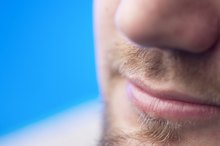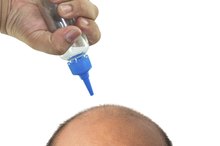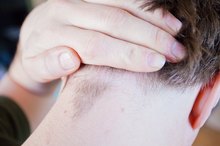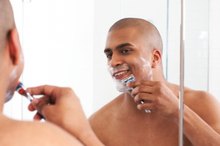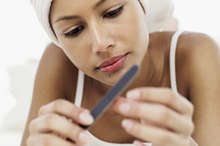Bumps on the Head After Shaving
The smooth, clean look of a shaved head can camouflage a receding hairline or provide cool comfort during the heat of summer. Unfortunately, a hairless scalp sometimes comes with a price. If you are prone to tiny red bumps on your head after shaving, the burn and itch can really make you regret ever putting a razor to your skin.
Identification
Pseudofolliculitis barbae is the clinical term for the little red bumps that develop on the scalp after shaving, according to Health Services at Columbia University 1. More commonly known as razor burn, the condition occurs when cut hairs curl inward towards the scalp and penetrate the hair follicles. The result is inflamed and irritated hair follicles that require immediate attention in order to avoid infection.
Solution
How to Prevent Ingrown Hairs in a Moustache
Learn More
Razor bumps usually resolve within five to seven days. During this time, it is important to keep the skin of your scalp clean. Daily washing with a mild soap is best. Western Washington University also explains that a topical hydrocortisone cream is also necessary to help heal the bumps and relieve itching and burning. A 1 percent hydrocortisone cream, sold over-the-counter can help control symptoms associated with the red bumps when applied two to three times a day. A pea-sized amount of hydrocortisone is all that is necessary for relief. Discontinue shaving your scalp until the bumps resolve.
- Razor bumps usually resolve within five to seven days.
- Western Washington University also explains that a topical hydrocortisone cream is also necessary to help heal the bumps and relieve itching and burning.
Warning
Even though the bumps may burn and itch, try to resist the urge to scratch. Scratching with your fingernails increases your chances of developing folliculitis, or infected hair follicles. Infected hair follicles can ooze and forms crusts of yellow pus over the affected area of scalp. Severe swelling, discoloration and tenderness can also develop with such scalp infections. If you develop any of these symptoms, Oregon State University explains that it is important to consult your physician. You may need an oral antibiotic to fight the infection.
- Even though the bumps may burn and itch, try to resist the urge to scratch.
- Scratching with your fingernails increases your chances of developing folliculitis, or infected hair follicles.
Prevention
How to Stop Hair From Itching When Growing
Learn More
To avoid developing bumps on your head after shaving, use a new, sharp blade each time you shave. Use a single-edged razor instead of multiple blades. Wet your head with warm water from the shower for at least 10 minutes before shaving to soften your skin and apply a shaving gel, which will lubricate your scalp and keep the razor flowing smoothly over your scalp. Also, always shave in the direction that your hair grows, avoiding stretching your scalp as you shave or running the razor over the same section of skin more than two times.
- To avoid developing bumps on your head after shaving, use a new, sharp blade each time you shave.
- Also, always shave in the direction that your hair grows, avoiding stretching your scalp as you shave or running the razor over the same section of skin more than two times.
Considerations
If razor bumps are an ongoing problem whenever you shave your head, you may want to reconsider the practice. If you absolutely must shave your head, avoid a close shave. The closer the shave, the more likely you are to develop razor burn. You may also want to consider waiting longer in between shaves. Scalp hair that is longer at the time of shaving is less likely to curl inward and irritate your hair follicles.
- If razor bumps are an ongoing problem whenever you shave your head, you may want to reconsider the practice.
Related Articles
References
- Health Services at Columbia University: Razor Bumps and Barber’s Rash
- Gray J, McMichael AJ. "Pseudofolliculitis Barbae: Understanding the Condition and the Role of Facial Grooming." International Journal of Cosmetic Science. 2016;38 Suppl 1:24-27.
- Zaenglein AL, Pathy AL, Schlosser BJ, Alikhan A., Baldwin HE, Berson D, et. al. "Guidelines of Care for the Management of Acne Vulgaris." Journal of the American Academy of Dermatology. 2016;74(5):945-973.
Writer Bio
Jonae Fredericks started writing in 2007. She also has a background as a licensed cosmetologist and certified skin-care specialist. Jonae Fredericks is a certified paraeducator, presently working in the public education system.
